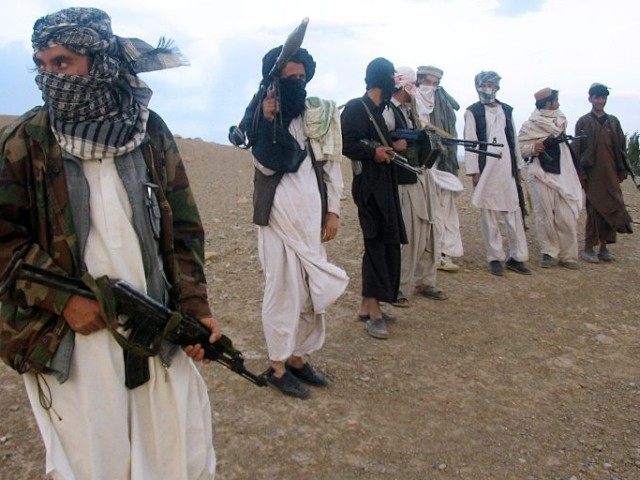The government of Afghanistan lost more territory to the Taliban in recent months, further plunging the number of districts under the control or influence of Kabul to unprecedented lows, a U.S. watchdog agency revealed in its latest report to Congress on Thursday.
Citing the American-NATO mission Resolute Support (RS), the U.S. Special Inspector General for Afghanistan Reconstruction (SIGAR) noted that as of the end of October 2018, “Afghan government control [74] or influence [145] over [the 407] districts declined by nearly two percentage points since July to 53.8%. Population control also declined by about two points to 63.5%.”
That means terrorist groups, mainly the Taliban, control/influence (50) or contest (138) slightly over 46 percent of Afghanistan’s 407 districts, marking an increase of nearly a percentage point since the last quarter, when SIGAR reported that the number of districts under the control or influence of Kabul “reached the lowest level” since the American government began keeping records in November 2015.
On Thursday, the watchdog agency also reported that predominantly Taliban-affiliated terrorist groups control, influence, or contest over 36 percent of the population.
In its quarterly report, which covers reconstruction efforts from the beginning of October to the end of December 2018, John Sopko, the SIGAR chief, explained:
The insurgency slightly increased its control or influence over areas where 10.8% of the population (3.6 million people) lived, a 0.3 percentage- point increase since last quarter but a decrease from the 12% reported in October 2017. The population living in contested areas increased to 8.5 million people (25.6% of the population), a nearly two percentage-point increase compared to the same period in 2017.
Most of the territory held by the Taliban sits in rural areas.
SIGAR has long used the number of districts under the control of the Afghan governments or terrorist groups as a metric of stability in Afghanistan.
“Multiple years with little variation in district stability data support multiple years of assessments that the conflict is in a stalemate,” the Pentagon acknowledged in commenting on SIGAR’s stability data.
However, in response to SIGAR’s data showing a decline in the Afghan government’s control of the population, the Pentagon argued:
Measures of population control are not indicative of effectiveness of [U.S. President Donald Trump’s] South Asia strategy or of progress toward security and stability in Afghanistan, particularly in the wake of the appointment of U.S. Special Representative for Afghanistan Reconciliation (SRAR) Zalmay Khalilzad.
The special representative has been leading intensified peace-seeking efforts by the U.S. over the last few months.
Pentagon officials asserted, “The [population control] percentages have varied little since the implementation of the South Asia strategy, which over the last 18 months has slowed Taliban gains made during U.S. drawdowns between 2011 and 2016.”
The U.S. Department of Defense (DOD) suggested that instead of spending time on population control data, people should focus on the Trump administration’s ultimate goal of “political reconciliation” between Kabul and the Taliban.
“DOD considers it more important to instead focus on the principal goal of the strategy of concluding the war in Afghanistan on terms favorable to Afghanistan and the United States,” the Pentagon said in comments to SIGAR.
Trump administration officials have made “political reconciliation” between Kabul and the Taliban the primary goal of its strategy to end the war, unveiled in August 2017.
“More aggressive combat operations by Afghan forces, increased authorities for U.S. forces to conduct supporting strikes, international calls for peace, and the new [reconciliation envoy’s] engagements appear to be driving the Taliban to substantive negotiations,” the Pentagon added. “Taliban participation in these talks suggests that the Taliban recognize that they cannot advance their interests militarily.”
The Trump administration has acknowledged that a military win is unattainable as the war has remained at a stalemate for the last few years.
In the wake of marathon discussions that concluded last weekend, the U.S. and the Taliban agreed to a framework for achieving a peace pact.
Under the framework, foreign forces would leave the country in exchange for assurances from the Taliban that it will not allow any other terrorist group to operate in Afghanistan, including its ally al-Qaeda and rival the Islamic State (ISIS/ISIL).
The United States is also requesting the Taliban to observe a ceasefire and open dialogue with the Afghan government in exchange for a pull out of foreign military forces.
Peace negotiations have taken place amid near-daily attacks against the U.S.-backed Afghan National Defense and Security Forces (ANDSF) that have killed and maimed scores of them and Afghan civilians. ANDSF includes police and military units.
“This quarter’s average daily incidents [attacks] is the highest of any quarter in 2018, but it remains slightly lower than the daily average over roughly the last three years (64.2),” SIGAR noted in its recent report.
Taliban narco-jihadis have long refused to negotiate with Kabul, dismissing the Afghan government as an American “puppet.”
The Taliban, which is fighting to implement strict Islamic laws or sharia, considers itself the only legitimate government in Afghanistan.
It remains unclear whether or not the U.S. will push the Taliban to cut its ties with opium and heroin, some of which is fueling the historic deadly drug overdose epidemic in the United States.
The Taliban generates most of its funding from the cultivating and trafficking the illicit drugs. Despite the U.S. spending over $8 billion on counternarcotics, Afghanistan remains the world’s top producer of opium, the main ingredient in heroin.
Most (over $83 billion) of the estimated $132 billion spent on Afghan reconstruction has been devoted to training and equipping the Afghan security forces who are still struggling against the Taliban.

COMMENTS
Please let us know if you're having issues with commenting.